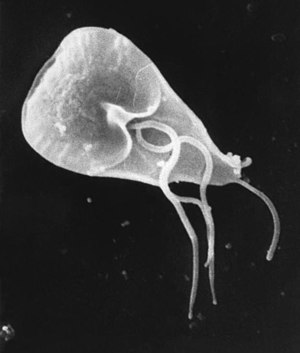Giardiasis
| Giardiasis | |
|---|---|
| Synonyms | beaver fever, giardia |
 |
|
| Giardia cell, SEM | |
| Specialty | infectious disease |
| Symptoms | diarrhea, abdominal pain |
| Usual onset | 1 to 3 weeks after exposure |
| Causes | Giardia lamblia |
| Diagnostic method | stool testing |
| Differential diagnosis | irritable bowel syndrome |
| Prevention | improved sanitation |
| Medication | tinidazole, metronidazole |
| Frequency | up to 7% (developed world), up to 30% (developing world) |
| Classification | |
|---|---|
| External resources |
Giardiasis, popularly known as beaver fever, is a parasitic disease caused by Giardia lamblia. About 10% of those infected have no symptoms. When symptoms occur they may include diarrhea, abdominal pain, and weight loss. Vomiting, blood in the stool, and fever are less common. Symptoms usually begin 1 to 3 weeks after exposure and without treatment may last up to six weeks.
Giardia usually spreads when Giardia lamblia cysts within feces contaminate food or water which is then eaten or drunk. It may also spread between people and from other animals. Risk factors include travel in the developing world, changing diapers, eating food without cooking it, and owning a dog. Cysts may survive for nearly three months in cold water. Diagnosis is via stool tests.
Prevention is typically by improved hygiene. Those without symptoms do not usually need treatment. When symptoms are present treatment is typically with either tinidazole or metronidazole. People may become temporarily lactose intolerant after an infection and therefore it is often recommended milk be avoided for a few weeks. Resistance to treatment may occur.
Giardia is one of the most common parasitic human diseases globally. In 2013, there were about 280 million people worldwide with symptomatic giardiasis. Rates are as high as 7% in the developed world and 30% in the developing world. The World Health Organization classified it as a neglected disease.
Symptoms vary from none to severe diarrhea with poor absorption of nutrients. It can result in weakness, loss of appetite, stomach cramps, vomiting, bloating, excessive gas, and burping. Symptoms typically develop 9–15 days after exposure, but may occur as early as one day.
...
Wikipedia
